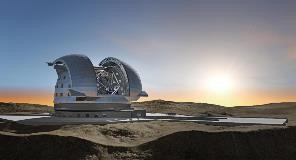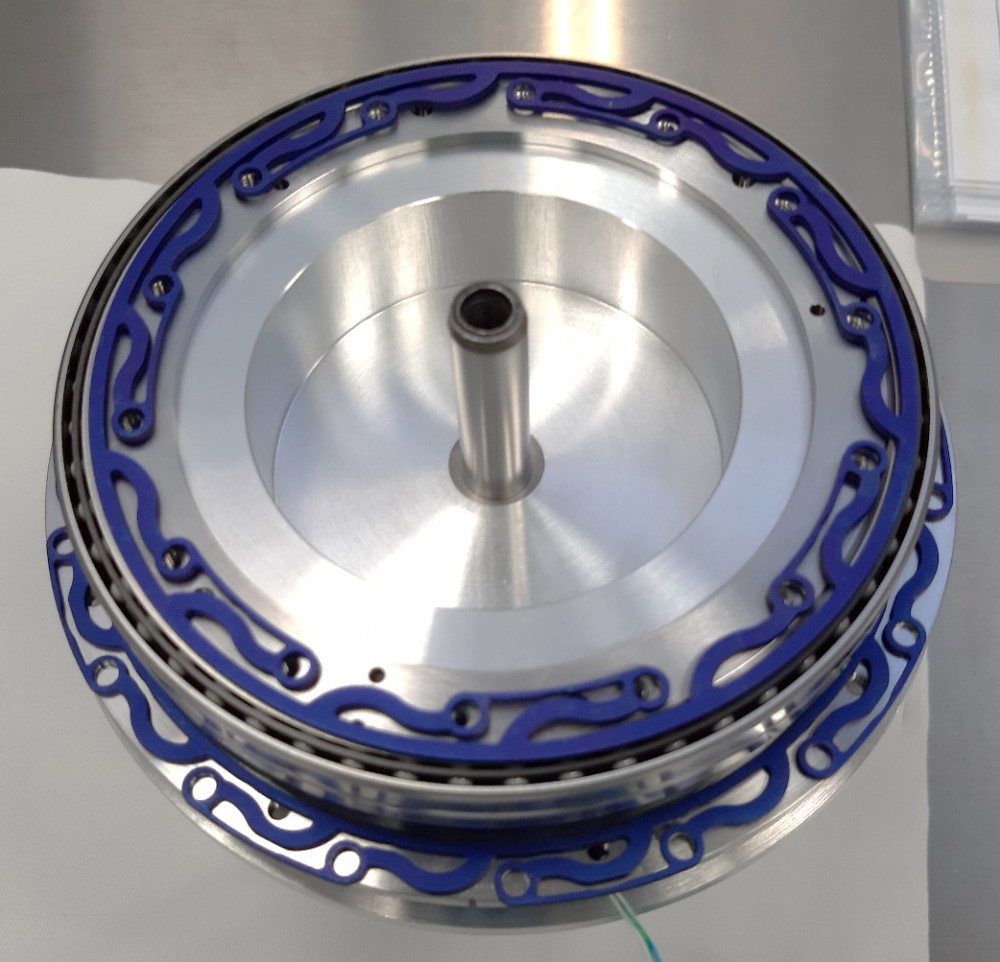The ICAR cryomechanisms that will equip the METIS instrument on the world’s largest telescope, the ELT, by 2029 have just passed the final design review by an ESO expert committee.
Resulting from a product lineage initiated in 1997 for the developments linked to the VISIR project (VLT Imager and Spectrometer for mid Indra Red), the CEA's cryomechanisms named ICAR (Indexed Cryogenic Actuator for Rotation) will equip the METIS instrument on the largest telescope in the world: the Extremely Large Telescope (ELT) by 2029. For this fifth generation of mechanisms (2004 VISIR, 2010 MIRI, 2012 CAMISTIC, 2017 EUCLID), the IRFU teams had to review the architecture of these mechanisms in order to significantly reduce their manufacturing costs, without degrading their performance (positioning repeatability of 15 µrad peak to peak). The ICAR cryomechanisms have just passed the final design review by a committee of experts from ESO (European Southern Observatory). With this success, the project can now enter the procurement phase for the qualification and series models.
See: video of the design and assembly stages of the prototype over the period 2018-2021

Genesis of an ICAR
The ingenious idea behind these mechanisms designed by IRFU over 20 years ago is the association of two elements that were not at all intended to work together. Firstly, a simple stepper motor allows a wheel supporting optical components to be placed at a given position, with a resolution of 1 motor step (1° in our case). Then, a tooth clutch, derived from the components used in industrial environments for power transmissions on rotating machines, locks this position with a high degree of angular repeatability. Thus was born the first prototype of the future ICAR cryomechanism. At this stage of development, this object was neither yet compatible with cryogenic environments nor the associated vacuum.
Although the basic building blocks were standard components of known technologies, a great effort was required to design a system capable of operating from 20°C down to temperatures of -260 °C. After a few years of development and several prototypes, the first version of the cryomechanism was produced in the late 1990s and 14 units (12 in the instrument and 2 replacement models) were manufactured for the VISIR (Vlt Imager and Spectrometer for Mid Infra Red) project. The VISIR cryomechanism is capable of placing a wheel supporting optics in accurate positions every degree (360 stable positions per revolution) which it achieves with a repeatability of ± 50 microradians (a grapefruit seen one kilometre away).

For the MIRI (Mid InfraRed Imager) project, IRFU obtained financial support from the CNES (Centre National d'Etudes Spatiales) to improve the mechanism in order to make it compatible with the specifications applicable to the filter wheel of the MIRI instrument on the JWST (James Webb Space Telescope). This study focused on the choice of materials, manufacturing processes, screws and highlighted the vulnerability of the design in terms of resistance to vibrations during a rocket launch.
The CAMISTIC project was an opportunity for IRFU to design a more compact model (200 positions per turn) and to introduce new improvements.
Between 2013 and 2017, IRFU contributed to the EUCLID project and our mechanisms were selected to move the filter wheel and the grism wheel (diffraction optics) on the NISP (Near Infrared Spectro-Photometer) instrument. The design of the cryomechanism was significantly revised as the mass of the wheels (about 6.5 kg) combined with the specified acceleration levels for the instrument (up to 25 g) required a new mechanical architecture. Thanks to a collaborative work between the DAp and DIS teams and the involvement of a leading industrial company (DMP AERO), the EUCLID cryomechanisms have successfully passed all the space qualification stages. This work was the subject of papers and presentations at the ESMATS-2017 (European Space Mechanism And Tribology Symposium) and SPIE-astronomical instrumentation and telescopes 2018 conferences. The two flight models were delivered in 2017 and are now mounted on the NISP instrument. The EUCLID satellite is scheduled for launch in 2022.
Using space-qualified components and processes and very high precision mechanical elements, EUCLID mechanisms have a high recurring cost.
In the context of the METIS project, an instrument installed on a ground-based telescope, a major cost reduction was undertaken. Going back to the basic bricks, the IRFU teams have completely revised the technical choices to meet the dual constraint of equipment that is as efficient as ever whilst drastically reducing costs (2.5 times less expensive).
Detailed design of the ICAR cryomechanisms
While the “space-qualified” stepper motor supplied by SAFRAN-ED remains an essential component, all the other components were analysed, weighing up their strengths, areas for improvement and production costs. For example, the very fine teeth that make up the indexing system (known as the clutch) were the subject of particular attention. Rather than specifying teeth with extreme accuracies and having to turn to high-precision mechanical companies to manufacture them, we turned to the gear manufacturing industries. By providing gear sets that meet the manufacturing standards of these companies, we were able to validate that the positioning performance was compatible with our needs at lower production costs. Similarly, end-user requirements vary in terms of the number of optical components to be implemented: for the NISP instrument, the wheels support 5 filters of ≈ 120 mm diameter, whereas the MIRI wheel supports 18 optical components of ≈ 25 mm diameter. Therefore, having a mechanism that can take 360 positions was a criterion that could be reconsidered.
In parallel, we took advantage of the studies carried out for the EUCLID program to select materials whose coefficients of expansion are compatible with each other and with those of the ball bearings. This is a strong constraint for the mechanism to operate from room temperature down to cryogenic temperatures without thermo-mechanical stress.
Tribological (rubbing against each other) surfaces must necessarily be lubricated. Vacuum and cryogenic environments prevent from the use of conventional oil or grease lubrication and require dry lubrication. If space projects require the use of European Space Agency (ESA) approved processes, the same lubricant can also be applied using similar processes but without ESA approval. The cost benefit is immediate.
The tooth profile used for the clutch guarantees the positioning performance of the ICAR cryomechanism over the entire temperature range. This tooth shape (known as “Hirth”) ensures backlash-free assembly and guarantees the centring of the parts between them. This same profile is also used for the interface parts, thus ensuring that our mechanism, which is mainly made of stainless steel, can be mounted on an aluminium structure and support wheels made of the same material.

Thus, an ICAR cryomechanism consists of the following elements:
- A stepper motor with 360 steps/revolution,
- A clutch system consisting of an electromagnet, a bellows and two 180-teeth Hirth gears.
- A pair of stainless steel ball bearings, lubricated with molybdenum disulphide
- A set of stainless steel mechanical parts to ensure the mechanical strength of the above components.
To validate the new design of the ICAR mechanism, a prototype was built in 2019. It has been undergoing intensive testing since early 2020. The performance achieved exceeds that of previous generations, since the angular positioning repeatability is 15 microradians (the size of a 1 euro coin seen at one kilometre away).
The devil is in the details.
Despite the experience acquired by our teams and the technical solutions adopted from previous generations, the ICAR mechanism very quickly showed a problem with its operation at very low temperatures. While the achieved performances were very satisfactory at room temperature and at cold temperatures (-220 °C), we noticed that the friction torque of the ball bearings increased significantly as the temperature dropped. This point focused the attention of the IRFU teams for a year and a half before being resolved. It was the close collaboration between mechanical engineering, instrumentation and testing skills, coupled in an integrated system approach, that enabled the origins of this phenomenon to be revealed.
By choosing to reduce the number of teeth in the clutch and to machine these teeth to a larger diameter, we had to enlarge the teeth. As a result, the electromagnet that separates the teeth must produce a stronger magnetic field.
As mentioned earlier, ICAR's ball bearings and structural parts are made of martensitic stainless steels, which have excellent mechanical properties, but can become easily magnetised. Once magnetised, these materials retain a remanent magnetisation which gives them a behaviour similar to small magnets (like some knife blades). Thus, we have demonstrated a coupling phenomenon between the bearing balls and the surrounding magnetic field. Replacing the stainless steel balls with ceramic (silicon nitride) balls disabled this phenomenon.
Similarly, having increased the diameter of the bearing while their cross-section remained unchanged, the influence of the differences in the coefficients of expansion between the material of the bearing (stainless steel) and that of the cage that holds the balls (brass) became more important. Our tests showed that the brass cages rubbed against the bearing races at very low temperatures. New cages made of VESPEL-SP3 (a “slippery” material compatible with vacuum and cryogenics) were designed at IRFU and produced by a manufacturer. Finally, these same expansion issues generate additional stresses that “crush” the cold bearings. Specific clamps have been designed at IRFU to generate a controlled effort over the entire temperature range.

Once this problem was solved, the testing of the ICAR cryomechanisms continued in the last quarter of 2020 with a lifetime test performed on 165,000 movements, corresponding to 18 years of observations on METIS. We were thus able to defend the final design review against an evaluation committee composed of ESO experts. The committee's report was delivered at the beginning of May 2021 with the status “passed” without any critical action and the congratulations of the project leader.
IRFU's ICAR cryomechanisms will operate a dozen optical systems on the Extremely Large Telescope's METIS infrared instrument. This video shows the work on the prototype for the period 2018-2021, from the first assemblies to the final design review. Directed by O. Corpace @IRFU

Beyond ICAR
For the METIS project, the CEA's contribution is not limited to supplying the 14 ICAR mechanisms. IRFU is also in charge of the design and manufacturing of the field derotator mechanism, whose function is to compensate for the rotation of the Earth so that the image of the sky on the detectors is stable during observations. This cryogenic derotator mechanism will be a world first since no other astrophysics instrument has chosen to place the derotator inside the cryostat. IRFU is also involved in the detailed characterisation of the METIS detectors and in the provision of a test facility that will allow the performance of the coronagraphic masks to be measured in the 8 to 12 µm wavelength range.
For the integration and testing of cryomechanisms, IRFU set up a dedicated platform that includes an integration zone in a clean room and cryostats using cryogenerators. This platform is reserved for the METIS project until 2024, but it will become available for R&D activities and new projects in 3 years.
The experience acquired by the IRFU teams gives us the legitimacy to continue the development of this technology line in order to participate in future space missions and other instruments for ground-based telescopes. Moreover, if the use of ICAR cryomechanisms has naturally tended towards astrophysics applications, other perspectives are possible, with for example, the positioning of cryogenic targets for particle physics or nuclear physics projects, or the implementation of beam diagnostics for particle accelerators.
Contacts: Jean-Christophe Barrriere, Olivier Corpace, Mickael Lacroix

